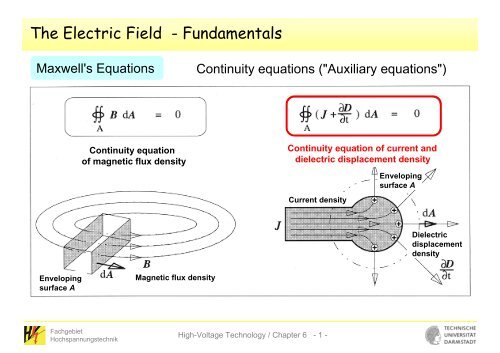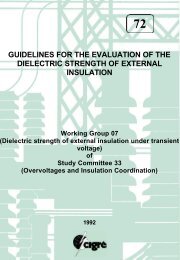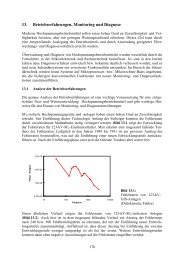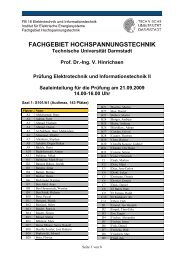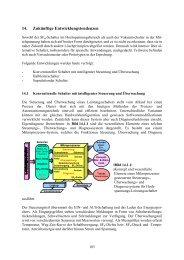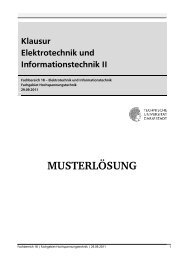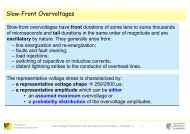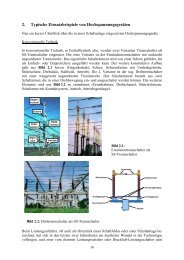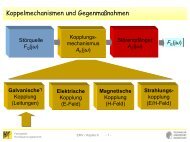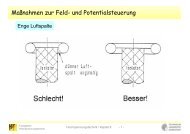R - Fachgebiet Hochspannungstechnik
R - Fachgebiet Hochspannungstechnik
R - Fachgebiet Hochspannungstechnik
Create successful ePaper yourself
Turn your PDF publications into a flip-book with our unique Google optimized e-Paper software.
The Electric Field - Fundamentals<br />
Maxwell's Equations<br />
Continuity equations ("Auxiliary equations")<br />
Continuity equation<br />
of magnetic flux density<br />
Continuity equation of current and<br />
dielectric displacement density<br />
Current density<br />
Enveloping<br />
surface A<br />
Dielectric<br />
displacement<br />
density<br />
Enveloping<br />
surface A<br />
Magnetic flux density<br />
<strong>Fachgebiet</strong><br />
<strong>Hochspannungstechnik</strong><br />
High-Voltage Technology / Chapter 6 - 1 -
The Electric Field - Fundamentals<br />
Maxwell's Equations<br />
Continuity equations ("Auxiliary equations")<br />
Continuity equation of current<br />
and dielectric displacement<br />
density:<br />
∫∫<br />
A<br />
⎛<br />
⎜J<br />
⎝<br />
∂D<br />
⎞<br />
+ ⎟dA=<br />
∂t<br />
⎠<br />
0<br />
Conversion:<br />
∫∫<br />
A<br />
∂D d A =− ∫∫<br />
J d A = i()<br />
t<br />
∂t<br />
A<br />
Integration over time:<br />
∫∫<br />
DA d = ∫i()<br />
t dt = Q<br />
A<br />
Gauss's law<br />
∫∫ DA= d<br />
A<br />
Q<br />
<strong>Fachgebiet</strong><br />
<strong>Hochspannungstechnik</strong><br />
High-Voltage Technology / Chapter 6 - 2 -
The Electric Field - Fundamentals<br />
Maxwell's Equations<br />
Continuity equations ("Auxiliary equations")<br />
Gauss's law:<br />
∫∫ DA= d<br />
A<br />
Q<br />
Enveloping<br />
surface A<br />
The charge Q equals the integral<br />
over the spatial charge density η in the<br />
volume V that is enclosed<br />
by the enveloping surface.<br />
Dielectric<br />
displacement<br />
density<br />
∫∫<br />
DA d<br />
A<br />
=<br />
∫∫∫<br />
V<br />
ηdV<br />
<strong>Fachgebiet</strong><br />
<strong>Hochspannungstechnik</strong><br />
High-Voltage Technology / Chapter 6 - 3 -
Analytical Solution of Gauss's Law<br />
The electric field of some simple basic geometrical<br />
configurations (e.g. spherical- or cylindrical-symmetric<br />
ones), may easily be evaluated by solution of the<br />
Gauss's law.<br />
Many of the more complex real configurations in highvoltage<br />
technology may be referred back to these basic<br />
configurations.<br />
DA= d<br />
Q<br />
A<br />
Four-step procedure (sometimes five-step procedure)<br />
<strong>Fachgebiet</strong><br />
<strong>Hochspannungstechnik</strong><br />
High-Voltage Technology / Chapter 6 - 4 -
Analytical Solution of Gauss's Law<br />
1 st step<br />
Resolution of Gauss's Law<br />
∫∫<br />
D d A<br />
A<br />
= Q<br />
to the absolute value of D<br />
Interdependence of charge (that causes the electric field) and<br />
local distribution of absolute value of electric field strength E = D/ε<br />
<strong>Fachgebiet</strong><br />
<strong>Hochspannungstechnik</strong><br />
High-Voltage Technology / Chapter 6 - 5 -
Analytical Solution of Gauss's Law<br />
2 nd step<br />
Evaluating the voltage difference by integration<br />
of the electric field strength along the path<br />
U<br />
21<br />
1<br />
= ∫ E ds<br />
2<br />
Interdependence of charge Q (that causes the electric field) and<br />
voltage U: Q = f(U)<br />
<strong>Fachgebiet</strong><br />
<strong>Hochspannungstechnik</strong><br />
High-Voltage Technology / Chapter 6 - 6 -
Analytical Solution of Gauss's Law<br />
3 rd step<br />
Evaluating the capacitance of the configuration<br />
Q<br />
C = U<br />
<strong>Fachgebiet</strong><br />
<strong>Hochspannungstechnik</strong><br />
High-Voltage Technology / Chapter 6 - 7 -
Analytical Solution of Gauss's Law<br />
4 th step<br />
Evaluating the interdependence of electric field strength E<br />
and voltage U from the results of 1 st and 2 nd step: E = f(U)<br />
<strong>Fachgebiet</strong><br />
<strong>Hochspannungstechnik</strong><br />
High-Voltage Technology / Chapter 6 - 8 -
Analytical Solution of Gauss's Law<br />
5 th step<br />
Evaluation of maximum electric field strength E max<br />
Optimization (e.g. minimization of electrical field strength E max )<br />
<strong>Fachgebiet</strong><br />
<strong>Hochspannungstechnik</strong><br />
High-Voltage Technology / Chapter 6 - 9 -
Analytical Solution of Gauss's Law<br />
Sphere in free space<br />
Point charge with opposite charge at infinity<br />
Enveloping<br />
surface A<br />
D is of same absolute value D(r) at any point<br />
in space at distance r (for reasons of symmetry)<br />
Vectors of D and A have the same<br />
direction at any point in space<br />
D·dA = D·dA<br />
Dielectric<br />
displacement<br />
density D<br />
Electric<br />
field<br />
strength E<br />
<strong>Fachgebiet</strong><br />
<strong>Hochspannungstechnik</strong><br />
High-Voltage Technology / Chapter 6 - 10 -
Analytical Solution of Gauss's Law<br />
1 st step<br />
Resolution of Gauss's Law<br />
∫∫<br />
D d A<br />
A<br />
= Q<br />
to the absolute value of D<br />
∫∫<br />
A<br />
DA<br />
2<br />
d = Dr () ∫∫<br />
dA= Dr () ⋅ Ar () = Dr ()4 ⋅ π r = Q<br />
A<br />
Dr () =<br />
Er () =<br />
Q<br />
2<br />
4π<br />
r<br />
Q<br />
4πε<br />
r<br />
2<br />
<strong>Fachgebiet</strong><br />
<strong>Hochspannungstechnik</strong><br />
High-Voltage Technology / Chapter 6 - 11 -
Analytical Solution of Gauss's Law<br />
2 nd step<br />
Evaluating the voltage difference by integration<br />
of the electric field strength along the path<br />
U<br />
21<br />
1<br />
2<br />
ds<br />
= ∫ E 2<br />
∞<br />
Q 1 Q ⎡ 1⎤<br />
Q<br />
U<br />
R∞<br />
= ∫E()<br />
r dr = ∫ dr = ⋅<br />
4πε r 4πε ⎢<br />
− =<br />
⎣ r⎥⎦<br />
4πεR<br />
R<br />
∞<br />
R<br />
∞<br />
R<br />
Q = 4πεRU<br />
<strong>Fachgebiet</strong><br />
<strong>Hochspannungstechnik</strong><br />
High-Voltage Technology / Chapter 6 - 12 -
Analytical Solution of Gauss's Law<br />
3 rd step<br />
Evaluating the capacitance of the configuration<br />
Q<br />
C = U<br />
C<br />
Q<br />
= =<br />
U<br />
4πε<br />
R<br />
<strong>Fachgebiet</strong><br />
<strong>Hochspannungstechnik</strong><br />
High-Voltage Technology / Chapter 6 - 13 -
Analytical Solution of Gauss's Law<br />
4 th step<br />
Evaluating the interdependence of electric field strength E<br />
and voltage U from the results of 1 st and 2 nd step: E = f(U)<br />
Q = 4πεRU<br />
Er ()<br />
=<br />
Q<br />
4πεr<br />
2<br />
1<br />
Enveloping<br />
surface A<br />
Er ()<br />
R<br />
= U⋅<br />
r<br />
2<br />
Dielectric<br />
displacement<br />
density D<br />
Electric<br />
field<br />
strength E<br />
E/E max<br />
0<br />
R<br />
r<br />
<strong>Fachgebiet</strong><br />
<strong>Hochspannungstechnik</strong><br />
High-Voltage Technology / Chapter 6 - 14 -
Analytical Solution of Gauss's Law<br />
5 th step<br />
Evaluation of maximum electric field strength E max<br />
Optimization (e.g. minimization of electrical field strength E max )<br />
R<br />
U<br />
Emax = E( R)<br />
= U = R<br />
2 R<br />
1<br />
E/E max<br />
0<br />
R<br />
r<br />
<strong>Fachgebiet</strong><br />
<strong>Hochspannungstechnik</strong><br />
High-Voltage Technology / Chapter 6 - 15 -
Capacitive Loading by Shielding Electrodes<br />
Sphere electrode for 1 MV alternating voltage<br />
Goal: to chose the radius<br />
such that there are no<br />
partial discharges.<br />
Maximum elctric field strength<br />
on the electrode surface:<br />
E<br />
max<br />
U<br />
=<br />
r<br />
K<br />
K<br />
<strong>Fachgebiet</strong><br />
<strong>Hochspannungstechnik</strong><br />
High-Voltage Technology / Chapter 6 - 16 -
Capacitive Loading by Shielding Electrodes<br />
Maximum allowed electric field<br />
strength in air to achieve freedom<br />
from partial discharges:<br />
E max = 25 kV/cm<br />
Required sphere radius:<br />
r<br />
K<br />
U<br />
1,4 MV<br />
K<br />
= = =<br />
Emax<br />
25 kV/cm<br />
56 cm<br />
<strong>Fachgebiet</strong><br />
<strong>Hochspannungstechnik</strong><br />
High-Voltage Technology / Chapter 6 - 17 -
Capacitive Loading by Shielding Electrodes<br />
Capacitance of a sphere to ground<br />
(ground at infinity):<br />
C K = 4 πε 0 ε r r k<br />
ε 0 = 8,86 pF/m<br />
C K = 1,11 r K = 62 pF<br />
⇒ Capacitive current: 20 mA<br />
⇒ Reactive power: 20 kVA<br />
<strong>Fachgebiet</strong><br />
<strong>Hochspannungstechnik</strong><br />
High-Voltage Technology / Chapter 6 - 18 -
Analytical Solution of Gauss's Law<br />
Concentric Spheres (Spheric Capacitor)<br />
Point charge with opposite charge at infinity<br />
Enveloping<br />
surface A<br />
D is of same absolute value D(r) at any point<br />
in space at distance r (for reasons of symmetry)<br />
Vectors of D and A have the same<br />
direction at any point in space<br />
D·dA = D·dA<br />
<strong>Fachgebiet</strong><br />
<strong>Hochspannungstechnik</strong><br />
High-Voltage Technology / Chapter 6 - 19 -
Analytical Solution of Gauss's Law<br />
1 st step<br />
Resolution of Gauss's Law<br />
∫∫<br />
D d A<br />
A<br />
= Q<br />
to the absolute value of D<br />
∫∫<br />
A<br />
DA<br />
∫∫<br />
2<br />
d = D() r dA= D() r ⋅ A() r = D()4<br />
r ⋅ π r = Q<br />
A<br />
Dr () =<br />
Er () =<br />
Q<br />
2<br />
4π<br />
r<br />
Q<br />
4πε<br />
r<br />
2<br />
same procedure as for sphere in free space<br />
<strong>Fachgebiet</strong><br />
<strong>Hochspannungstechnik</strong><br />
High-Voltage Technology / Chapter 6 - 20 -
Analytical Solution of Gauss's Law<br />
2 nd step<br />
Evaluating the voltage difference by integration<br />
of the electric field strength along the path<br />
1<br />
U<br />
21<br />
2<br />
ds<br />
= ∫ E Enveloping<br />
R<br />
R<br />
2 2<br />
2<br />
Q 1 Q ⎡ 1⎤<br />
Q ⎛ 1 1 ⎞ Q R − R<br />
URR<br />
= E()<br />
r dr dr<br />
1 2 ∫ = ∫ = ⋅ − = ⋅ − = ⋅<br />
R<br />
⎣ ⎦ ⎝ ⎠<br />
1 1<br />
R<br />
2 1<br />
2<br />
4πε r 4πε ⎢ r⎥ ⎜ ⎟<br />
R<br />
4πε R1 R2 4πε<br />
R<br />
R<br />
1⋅<br />
R2<br />
1<br />
R1⋅<br />
R2<br />
Q = 4πεU ⋅ R − R<br />
2 1<br />
surface A<br />
<strong>Fachgebiet</strong><br />
<strong>Hochspannungstechnik</strong><br />
High-Voltage Technology / Chapter 6 - 21 -
Analytical Solution of Gauss's Law<br />
3 rd step<br />
Evaluating the capacitance of the configuration<br />
Q<br />
C = U<br />
Q R1⋅<br />
R2<br />
C = = 4πε<br />
⋅ U R − R<br />
2 1<br />
Gap spacing: s = R 2 - R 1<br />
s<br />
Enveloping<br />
surface A<br />
C<br />
= 4πε<br />
R ⋅<br />
1<br />
s<br />
+ R<br />
s<br />
1<br />
<strong>Fachgebiet</strong><br />
<strong>Hochspannungstechnik</strong><br />
High-Voltage Technology / Chapter 6 - 22 -
Analytical Solution of Gauss's Law<br />
Concentric spheres<br />
Sphere in free space<br />
C<br />
= 4πε<br />
R ⋅<br />
1<br />
s<br />
+ R<br />
s<br />
1<br />
C<br />
Q<br />
= =<br />
U<br />
4πε<br />
R<br />
s<br />
Enveloping<br />
surface A<br />
Enveloping<br />
surface A<br />
Dielectric<br />
displacement<br />
density D<br />
Electric<br />
field<br />
strength E<br />
⎛<br />
Cconc. = Cfree ⋅ ⎜1+<br />
R<br />
⎝ s<br />
1<br />
⎞<br />
⎟<br />
⎠<br />
C conc. always larger than C free<br />
<strong>Fachgebiet</strong><br />
<strong>Hochspannungstechnik</strong><br />
High-Voltage Technology / Chapter 6 - 23 -
Analytical Solution of Gauss's Law<br />
4 th step<br />
Evaluating the interdependence of electric field strength E<br />
and voltage U from the results of 1 st and 2 nd step: E = f(U)<br />
R1⋅<br />
R2<br />
Q= 4πεU⋅<br />
R − R<br />
2 1<br />
1<br />
Er ()<br />
=<br />
Q<br />
4πεr<br />
2<br />
E/E max<br />
R<br />
⋅ R<br />
1<br />
1 2<br />
Er () = U⋅ ⋅ R<br />
2<br />
2<br />
− R<br />
1 r<br />
0<br />
R<br />
r<br />
<strong>Fachgebiet</strong><br />
<strong>Hochspannungstechnik</strong><br />
High-Voltage Technology / Chapter 6 - 24 -
Analytical Solution of Gauss's Law<br />
5 th step<br />
Evaluation of maximum electric field strength E max<br />
Optimization (e.g. minimization of electrical field strength E max )<br />
R<br />
⋅ R<br />
1<br />
1 2<br />
Er () = U⋅ ⋅ R<br />
2<br />
2<br />
− R<br />
1 r<br />
1<br />
E max for r = R 1<br />
E<br />
max<br />
U R2<br />
= ⋅<br />
R R − R<br />
1 2 1<br />
E/E max<br />
0<br />
R 1<br />
r<br />
<strong>Fachgebiet</strong><br />
<strong>Hochspannungstechnik</strong><br />
High-Voltage Technology / Chapter 6 - 25 -
Analytical Solution of Gauss's Law<br />
Concentric spheres<br />
Spheres in free space<br />
E<br />
max<br />
U R2<br />
= ⋅<br />
R R − R<br />
1 2 1<br />
Emax = E( R)<br />
=<br />
U<br />
R<br />
E<br />
max<br />
= E ⋅<br />
max, free<br />
R<br />
R2<br />
− R<br />
2 1<br />
E max, conc. always larger than E max, free<br />
Example.... R 2 = 5·R 1<br />
E max, conc = 1.25·E max, free<br />
Further example.....<br />
Transformer shielding sphere<br />
<strong>Fachgebiet</strong><br />
<strong>Hochspannungstechnik</strong><br />
High-Voltage Technology / Chapter 6 - 26 -
Analytical Solution of Gauss's Law<br />
5 th step<br />
Evaluation of maximum electric field strength E max<br />
Optimization (e.g. minimization of electrical field strength E max )<br />
E<br />
max<br />
U R2<br />
= ⋅<br />
R R − R<br />
1 2 1<br />
R 1 = 0<br />
R 1 = R 2<br />
E max →∞<br />
E max →∞<br />
(at R 2 unchanged)<br />
There must be a minimum of maximum field strength!<br />
<strong>Fachgebiet</strong><br />
<strong>Hochspannungstechnik</strong><br />
High-Voltage Technology / Chapter 6 - 27 -
Analytical Solution of Gauss's Law<br />
5 th step<br />
Evaluation of maximum electric field strength E max<br />
Optimization (e.g. minimization of electrical field strength E max )<br />
Putting the derivative<br />
∂E<br />
max<br />
∂R<br />
1<br />
to zero<br />
......<br />
R =<br />
1, opt<br />
R<br />
2<br />
2<br />
E<br />
max, opt<br />
=<br />
4U<br />
R<br />
2<br />
<strong>Fachgebiet</strong><br />
<strong>Hochspannungstechnik</strong><br />
High-Voltage Technology / Chapter 6 - 28 -
Analytical Solution of Gauss's Law<br />
E max /E max, min<br />
Krümmungseffekt<br />
Abstandseffekt<br />
E<br />
max, opt<br />
=<br />
4U<br />
R<br />
2<br />
R 1 /R 2 = 0,5<br />
R 1 /R 2<br />
<strong>Fachgebiet</strong><br />
<strong>Hochspannungstechnik</strong><br />
High-Voltage Technology / Chapter 6 - 29 -
Analytical Solution of Gauss's Law<br />
5 th step<br />
Evaluation of maximum electric field strength E max<br />
Optimization (e.g. minimization of electrical field strength E max )<br />
Further considerations:<br />
E<br />
max<br />
U R2<br />
= ⋅<br />
R R − R<br />
1 2 1<br />
Gap spacing: s = R 2 - R 1<br />
E<br />
max<br />
U R U U<br />
R R − R R s<br />
2<br />
= ⋅ = +<br />
1 2 1 1<br />
<strong>Fachgebiet</strong><br />
<strong>Hochspannungstechnik</strong><br />
High-Voltage Technology / Chapter 6 - 30 -
Analytical Solution of Gauss's Law<br />
E<br />
max<br />
U R U U<br />
R R − R R s<br />
2<br />
= ⋅ = +<br />
1 2 1 1<br />
Maximum electric field strength<br />
of a sphere in free space<br />
Electric field strength of an homogeneous<br />
configuration of gap spacing s<br />
<strong>Fachgebiet</strong><br />
<strong>Hochspannungstechnik</strong><br />
High-Voltage Technology / Chapter 6 - 31 -
Analytical Solution of Gauss's Law<br />
E<br />
max<br />
U R U U<br />
R R − R R s<br />
2<br />
= ⋅ = +<br />
1 2 1 1<br />
Curvature effect:<br />
U U U<br />
R > → E ≈<br />
1 max<br />
R1 s R1<br />
• Electric field strength governed by sphere radius<br />
• Increase of gap spacing of virtually no impact<br />
on maximum electric field strength<br />
<strong>Fachgebiet</strong><br />
<strong>Hochspannungstechnik</strong><br />
High-Voltage Technology / Chapter 6 - 32 -
Analytical Solution of Gauss's Law<br />
E<br />
max<br />
U R U U<br />
R R − R R s<br />
2<br />
= ⋅ = +<br />
1 2 1 1<br />
Distance effect:<br />
U U U<br />
R >> s →
Analytical Solution of Gauss's Law<br />
E max /E max, min<br />
Distance-<br />
Krümmungseffekt<br />
Curvatureeffect<br />
Abstandseffekeffect<br />
R 1 /R 2 = 0,5 0.5<br />
R 1 /R 2<br />
<strong>Fachgebiet</strong><br />
<strong>Hochspannungstechnik</strong><br />
High-Voltage Technology / Chapter 6 - 34 -<br />
l
Analytical Solution of Gauss's Law<br />
Configurations similar to "sphere in free space" and<br />
"concentric sphere"-configuration<br />
Connector of<br />
high-voltage leads<br />
Shielding electrode<br />
in the corner of an<br />
high-voltage lab<br />
Shielding electrode<br />
in free space<br />
Elbow of<br />
a GIS<br />
Pressurized gas<br />
capacitor<br />
<strong>Fachgebiet</strong><br />
<strong>Hochspannungstechnik</strong><br />
High-Voltage Technology / Chapter 6 - 35 -
Analytical Solution of Gauss's Law<br />
Coaxial cylinders<br />
Coaxial configuration of length z<br />
Enveloping<br />
surface A<br />
Stray effects at the edges neglected<br />
D is of same absolute value D(r) at any point<br />
in space at distance r (for reasons of symmetry)<br />
Vectors of D and A have the same<br />
direction at any point in space<br />
D·dA = D·dA<br />
<strong>Fachgebiet</strong><br />
<strong>Hochspannungstechnik</strong><br />
High-Voltage Technology / Chapter 6 - 36 -
Analytical Solution of Gauss's Law<br />
1 st step<br />
Resolution of Gauss's Law<br />
∫∫<br />
D d A<br />
A<br />
= Q<br />
to the absolute value of D<br />
∫∫<br />
A<br />
∫∫<br />
DA d = Dr () dA= Dr () ⋅ Ar () = Dr ()2 ⋅ π rz=<br />
Q<br />
A<br />
Dr () =<br />
Er () =<br />
Q<br />
2π<br />
rz<br />
Q<br />
2πε<br />
rz<br />
similar dependencies as for concentric spheres (but decrease with 1/r)<br />
<strong>Fachgebiet</strong><br />
<strong>Hochspannungstechnik</strong><br />
High-Voltage Technology / Chapter 6 - 37 -
Analytical Solution of Gauss's Law<br />
2 nd step<br />
Evaluating the voltage difference by integration<br />
of the electric field strength along the path<br />
1<br />
U<br />
21<br />
= ∫ E ds<br />
2<br />
R<br />
2 2<br />
Q 1 Q R2<br />
Q R<br />
URR<br />
= () [ ln ] ln<br />
1 2 ∫ E r dr = dr r<br />
R1<br />
2πε z∫<br />
= ⋅ = ⋅<br />
r 2πε z 2πε<br />
z R<br />
R<br />
1 1<br />
R<br />
R<br />
2<br />
1<br />
Q<br />
2πε<br />
z<br />
= ⋅U<br />
R2<br />
ln<br />
R<br />
1<br />
Enveloping<br />
surface A<br />
<strong>Fachgebiet</strong><br />
<strong>Hochspannungstechnik</strong><br />
High-Voltage Technology / Chapter 6 - 38 -
Analytical Solution of Gauss's Law<br />
3 rd step<br />
Evaluating the capacitance of the configuration<br />
Q<br />
C = U<br />
C<br />
Q<br />
= =<br />
U<br />
2πε<br />
z<br />
R2<br />
ln<br />
R<br />
1<br />
<strong>Fachgebiet</strong><br />
<strong>Hochspannungstechnik</strong><br />
High-Voltage Technology / Chapter 6 - 39 -
Analytical Solution of Gauss's Law<br />
4 th step<br />
Evaluating the interdependence of electric field strength E<br />
and voltage U from the results of 1 st and 2 nd step: E = f(U)<br />
Q<br />
2πε<br />
z<br />
= ⋅U<br />
R2<br />
ln<br />
R<br />
1<br />
Er ()<br />
=<br />
Q<br />
2πεrz<br />
Er ()<br />
=<br />
r<br />
U<br />
⋅ln<br />
R<br />
R<br />
2<br />
1<br />
<strong>Fachgebiet</strong><br />
<strong>Hochspannungstechnik</strong><br />
High-Voltage Technology / Chapter 6 - 40 -
Analytical Solution of Gauss's Law<br />
E<br />
U/R 1<br />
1<br />
konzentrische Concentric spheres Kugeln<br />
Kugel Sphere frei in im free Raum space<br />
koaxiale Coaxial cylinders Zylinder<br />
Sphere in free space<br />
Er ()<br />
R<br />
= U⋅<br />
r<br />
2<br />
Concentric spheres<br />
R<br />
⋅ R<br />
1<br />
1 2<br />
Er () = U⋅ ⋅ R<br />
2<br />
2<br />
− R<br />
1 r<br />
r/R 1<br />
(R 5·R 1 = 1) (R 2 = 1 )<br />
Relative electric field distributions in comparison: sphere in free space,<br />
concentric spheres, coaxial cylinders<br />
Coaxial cylinders<br />
U<br />
Er () =<br />
R2<br />
r ⋅ln<br />
R<br />
1<br />
<strong>Fachgebiet</strong><br />
<strong>Hochspannungstechnik</strong><br />
High-Voltage Technology / Chapter 6 - 41 -
Analytical Solution of Gauss's Law<br />
5 th step<br />
Evaluation of maximum electric field strength E max<br />
Er () =<br />
U<br />
r ⋅ln<br />
R<br />
2<br />
R1<br />
E max for r = R 1<br />
Optimization (e.g. minimization of electrical field strength E max )<br />
E<br />
= E =<br />
max 1<br />
R<br />
1<br />
U<br />
⋅ln<br />
R<br />
R<br />
2<br />
1<br />
<strong>Fachgebiet</strong><br />
<strong>Hochspannungstechnik</strong><br />
High-Voltage Technology / Chapter 6 - 42 -
Analytical Solution of Gauss's Law<br />
5 th step<br />
Evaluation of maximum electric field strength E max<br />
Optimization (e.g. minimization of electrical field strength E max )<br />
E<br />
max 1<br />
R 1 = 0<br />
= E =<br />
R<br />
1<br />
U<br />
⋅ln<br />
R<br />
R<br />
2<br />
1<br />
E max →∞<br />
R 1 = R 2<br />
E max →∞<br />
There must be a minimum of maximum field strength!<br />
<strong>Fachgebiet</strong><br />
<strong>Hochspannungstechnik</strong><br />
High-Voltage Technology / Chapter 6 - 43 -
Analytical Solution of Gauss's Law<br />
5 th step<br />
Evaluation of maximum electric field strength E max<br />
Optimization (e.g. minimization of electrical field strength E max )<br />
E<br />
∂Emax<br />
Putting the derivative to zero ......<br />
⎛R<br />
⎞<br />
2<br />
∂ ⎜ ⎟<br />
⎝ R1<br />
⎠<br />
U U R<br />
= E = = ⋅<br />
R<br />
R1<br />
⋅ln<br />
R<br />
ln<br />
R<br />
max 1<br />
R<br />
R<br />
R<br />
2 1<br />
2 2 2<br />
1 1<br />
u<br />
v<br />
What is needed?<br />
' ' '<br />
⎛u⎞ uv − uv<br />
Quotientenregel : ⎜ ⎟ =<br />
2<br />
⎝v<br />
⎠ v<br />
d ( ln x)=<br />
1<br />
dx<br />
x<br />
<strong>Fachgebiet</strong><br />
<strong>Hochspannungstechnik</strong><br />
High-Voltage Technology / Chapter 6 - 44 -
Analytical Solution of Gauss's Law<br />
5 th step<br />
Evaluation of maximum electric field strength E max<br />
Optimization (e.g. minimization of electrical field strength E max )<br />
max<br />
Putting the derivative to zero ......<br />
⎛ R<br />
⎜<br />
⎝ R<br />
R<br />
2<br />
1<br />
⎞<br />
⎟<br />
⎠<br />
opt<br />
= e =<br />
2<br />
1, opt 2<br />
∂E<br />
⎛R<br />
∂ ⎜<br />
⎝ R<br />
2,718<br />
Optimized maximum el. field strength:<br />
R<br />
= = 0,368⋅R<br />
Emax, opt<br />
e<br />
2<br />
1<br />
⎞<br />
⎟<br />
⎠<br />
U U e⋅U<br />
= = =<br />
⎛ R ⎞ R<br />
2<br />
1, opt<br />
R2<br />
R1, opt<br />
ln ⎜ ⎟<br />
⎝ R ⎠<br />
1 opt<br />
<strong>Fachgebiet</strong><br />
<strong>Hochspannungstechnik</strong><br />
High-Voltage Technology / Chapter 6 - 45 -
Analytical Solution of Gauss's Law<br />
Concentric spheres<br />
Coaxial cylinders<br />
E<br />
max, opt<br />
4U<br />
R<br />
= max, opt<br />
2<br />
E<br />
=<br />
eU ⋅<br />
R<br />
2<br />
E max for concentric spheres always larger than for coaxial cylinders<br />
Reason: Curvature in further dimension of space (z-direction)<br />
<strong>Fachgebiet</strong><br />
<strong>Hochspannungstechnik</strong><br />
High-Voltage Technology / Chapter 6 - 46 -
Analytical Solution of Gauss's Law<br />
E 1<br />
E 1, opt R 1 = R 2 /e<br />
E 1, opt<br />
R 1 /R 2<br />
But: û d,max at smaller ratio of radii than 1/e<br />
<strong>Fachgebiet</strong><br />
<strong>Hochspannungstechnik</strong><br />
High-Voltage Technology / Chapter 6 - 47 -
Analytical Solution of Gauss's Law<br />
Homogeneous field (plate capacitor)<br />
Stray effects at the edges neglected<br />
D is of same absolute value D at any point<br />
of enveloping surface A<br />
Vectors of D and A have the same<br />
direction at any point in space<br />
D·dA = D·dA<br />
Enveloping<br />
surface A<br />
s<br />
<strong>Fachgebiet</strong><br />
<strong>Hochspannungstechnik</strong><br />
High-Voltage Technology / Chapter 6 - 48 -
Analytical Solution of Gauss's Law<br />
1 st step<br />
Resolution of Gauss's Law<br />
∫∫<br />
D d A<br />
A<br />
= Q<br />
to the absolute value of D<br />
∫∫<br />
A<br />
∫∫<br />
DA d = D dA= D⋅ A=<br />
Q<br />
A<br />
Q<br />
Dx ( ) = = const.<br />
A<br />
Q<br />
Ex ( ) = = const.<br />
= E<br />
ε A<br />
0<br />
<strong>Fachgebiet</strong><br />
<strong>Hochspannungstechnik</strong><br />
High-Voltage Technology / Chapter 6 - 49 -
Analytical Solution of Gauss's Law<br />
2 nd step<br />
Evaluating the voltage difference by integration<br />
of the electric field strength along the path<br />
1<br />
U<br />
21<br />
= ∫ E ds<br />
2<br />
s<br />
Q s<br />
U = ⋅<br />
∫ E( x)<br />
dx = E ⋅ s = ε ⋅ A<br />
0<br />
Q<br />
=<br />
ε ⋅<br />
A⋅U<br />
s<br />
<strong>Fachgebiet</strong><br />
<strong>Hochspannungstechnik</strong><br />
High-Voltage Technology / Chapter 6 - 50 -
Analytical Solution of Gauss's Law<br />
3 rd step<br />
Evaluating the capacitance of the configuration<br />
Q<br />
C = U<br />
Q<br />
=<br />
ε ⋅<br />
A⋅U<br />
s<br />
Q ε ⋅ A<br />
C = = U s<br />
<strong>Fachgebiet</strong><br />
<strong>Hochspannungstechnik</strong><br />
High-Voltage Technology / Chapter 6 - 51 -
Analytical Solution of Gauss's Law<br />
4 th step<br />
Evaluating the interdependence of electric field strength E<br />
and voltage U from the results of 1 st and 2 nd step: E = f(U)<br />
Q<br />
ε ⋅A⋅U<br />
s<br />
Q<br />
Ex ( ) = = const.<br />
= E<br />
ε A<br />
=<br />
0<br />
Q U<br />
Ex ( ) = = = const.<br />
ε ⋅ A s<br />
<strong>Fachgebiet</strong><br />
<strong>Hochspannungstechnik</strong><br />
High-Voltage Technology / Chapter 6 - 52 -
Analytical Solution of Gauss's Law<br />
Borda profile (left) and Rogowski profile (right)<br />
<strong>Fachgebiet</strong><br />
<strong>Hochspannungstechnik</strong><br />
High-Voltage Technology / Chapter 6 - 53 -
Analytical Solution of Gauss's Law<br />
Electric field at the edge of a plate capacitor of Borda profile<br />
<strong>Fachgebiet</strong><br />
<strong>Hochspannungstechnik</strong><br />
High-Voltage Technology / Chapter 6 - 54 -
Utilization Factors according to Schwaiger<br />
Utilization factor<br />
η =<br />
E<br />
E<br />
0<br />
max<br />
Degree of inhomogenity<br />
1 E<br />
E<br />
max<br />
0<br />
E<br />
0<br />
U<br />
=<br />
s<br />
Electric field of an homogeneous<br />
configuration of same spacing<br />
"average electric field strength"<br />
η = 1 1<br />
η ≤ 1<br />
and<br />
η ≥ , resp.<br />
<strong>Fachgebiet</strong><br />
<strong>Hochspannungstechnik</strong><br />
High-Voltage Technology / Chapter 6 - 55 -
Utilization Factors according to Schwaiger<br />
η is a function of the geometrical characteristic, i.e. of variables p and q:<br />
p<br />
=<br />
s<br />
+<br />
r<br />
r<br />
2r<br />
2R<br />
2r<br />
s<br />
2r<br />
s<br />
2R<br />
q<br />
=<br />
R<br />
r<br />
2R<br />
2r<br />
s<br />
q = ∞<br />
r ... radius of electrode of more pronounced curvature<br />
R ... radius of electrode of less pronounced curvature<br />
<strong>Fachgebiet</strong><br />
<strong>Hochspannungstechnik</strong><br />
High-Voltage Technology / Chapter 6 - 56 -
Utilization Factors according to Schwaiger<br />
Tables ......<br />
<strong>Fachgebiet</strong><br />
<strong>Hochspannungstechnik</strong><br />
High-Voltage Technology / Chapter 6 - 57 -
Utilization Factors according to Schwaiger<br />
... or curves<br />
Spheres<br />
<strong>Fachgebiet</strong><br />
<strong>Hochspannungstechnik</strong><br />
High-Voltage Technology / Chapter 6 - 58 -
Utilization Factors according to Schwaiger<br />
Breakdown voltage<br />
Û d = Ê d·s·η<br />
But.....<br />
Ê d depends on<br />
geometry!<br />
Breakdown electric field strength of air<br />
at 1013 hPa, 20 °C<br />
acc. to W. O. Schumann: "Elektrische Durchbruchfeldstärke von<br />
Gasen", Springer 1923<br />
for cylinders<br />
for spheres<br />
for plates<br />
<strong>Fachgebiet</strong><br />
<strong>Hochspannungstechnik</strong><br />
High-Voltage Technology / Chapter 6 - 59 -
Rules for 2D Graphical Electric Field Evaluation<br />
z: length of configuration<br />
Field lines and equipotential lines are perpendicular to each other.<br />
<strong>Fachgebiet</strong><br />
<strong>Hochspannungstechnik</strong><br />
High-Voltage Technology / Chapter 6 - 60 -
Rules for 2D Graphical Electric Field Evaluation<br />
z: length of configuration<br />
Electrode surface lines are equipotential lines.<br />
<strong>Fachgebiet</strong><br />
<strong>Hochspannungstechnik</strong><br />
High-Voltage Technology / Chapter 6 - 61 -
Rules for 2D Graphical Electric Field Evaluation<br />
High-voltage potential<br />
Reference potential<br />
z: length of configuration<br />
The potential distribution is given in percentage values.<br />
<strong>Fachgebiet</strong><br />
<strong>Hochspannungstechnik</strong><br />
High-Voltage Technology / Chapter 6 - 62 -
Rules for 2D Graphical Electric Field Evaluation<br />
ΔU = a·E<br />
z: length of configuration<br />
Distance a between two equiquipotential lines is equal to<br />
always the same potential difference ΔU.<br />
<strong>Fachgebiet</strong><br />
<strong>Hochspannungstechnik</strong><br />
High-Voltage Technology / Chapter 6 - 63 -
Rules for 2D Graphical Electric Field Evaluation<br />
ΔQ = D·ΔA = ε·E·ΔA = ε·E·b·z<br />
z: length of configuration<br />
Distance b between two field lines is equal to<br />
always the same charge difference ΔQ on the electrode surfaces.<br />
<strong>Fachgebiet</strong><br />
<strong>Hochspannungstechnik</strong><br />
High-Voltage Technology / Chapter 6 - 64 -
Rules for 2D Graphical Electric Field Evaluation<br />
Rectangular mesh at<br />
edge lengths a and b<br />
Capacitance per mesh cell<br />
at edge lengths a and b:<br />
ΔQ ε ⋅E⋅b⋅z b<br />
Δ C = = = ε ⋅z⋅ = const.<br />
ΔU a⋅E a<br />
z: length of configuration<br />
Thus, also b/a = const.<br />
Appropriate choice:<br />
b/a = 1<br />
<strong>Fachgebiet</strong><br />
<strong>Hochspannungstechnik</strong><br />
High-Voltage Technology / Chapter 6 - 65 -
Rules for 2D Graphical Electric Field Evaluation<br />
z: length of configuration<br />
b/a = 1<br />
All four edges of a mesh cell must touch inscribed circles.<br />
<strong>Fachgebiet</strong><br />
<strong>Hochspannungstechnik</strong><br />
High-Voltage Technology / Chapter 6 - 66 -
Rules for 2D Graphical Electric Field Evaluation<br />
Total capacitance:<br />
np<br />
C = ⋅Δ C = ε ⋅z⋅<br />
n<br />
s<br />
n<br />
n<br />
p<br />
s<br />
z: length of configuration<br />
n p … number of cells in parallel<br />
n s … number of cells in series<br />
<strong>Fachgebiet</strong><br />
<strong>Hochspannungstechnik</strong><br />
High-Voltage Technology / Chapter 6 - 67 -
Rules for 2D Graphical Electric Field Evaluation<br />
Example: Electric field at the edge of a plate capacitor<br />
Rough approximation of field and potential distribution<br />
<strong>Fachgebiet</strong><br />
<strong>Hochspannungstechnik</strong><br />
High-Voltage Technology / Chapter 6 - 68 -
Rules for 2D Graphical Electric Field Evaluation<br />
Example: Electric field at the edge of a plate capacitor<br />
Improved field and potential distribution<br />
<strong>Fachgebiet</strong><br />
<strong>Hochspannungstechnik</strong><br />
High-Voltage Technology / Chapter 6 - 69 -
Rules for 2D Graphical Electric Field Evaluation<br />
Example: Electric field at the edge of a plate capacitor<br />
Further improved field and potential distribution<br />
<strong>Fachgebiet</strong><br />
<strong>Hochspannungstechnik</strong><br />
High-Voltage Technology / Chapter 6 - 70 -


